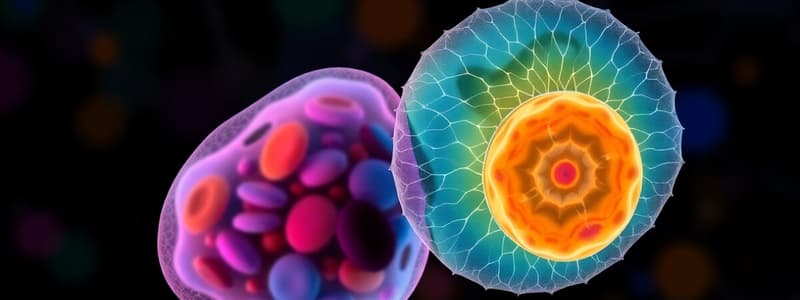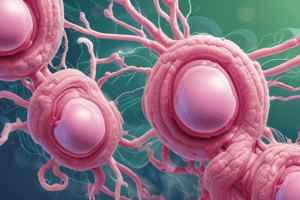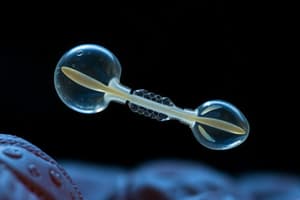Podcast
Questions and Answers
During which meiotic phase does crossing over primarily occur, leading to genetic variation?
During which meiotic phase does crossing over primarily occur, leading to genetic variation?
- Metaphase II
- Telophase II
- Anaphase I
- Prophase I (correct)
What cellular process is responsible for reducing the chromosome number from diploid to haploid?
What cellular process is responsible for reducing the chromosome number from diploid to haploid?
- Cleavage
- Mitosis
- Meiosis (correct)
- Fertilization
What is the significance of 'totipotency' in the context of early embryo development?
What is the significance of 'totipotency' in the context of early embryo development?
- The ability to only form placental tissues.
- The inability of a cell to undergo mitotic divisions.
- The restricted capability to develop into a limited range of cell types.
- The capacity of a cell to differentiate into any cell type of the organism, including extra-embryonic tissues. (correct)
Which of the following mechanisms contributes to the formation of the blastocoele?
Which of the following mechanisms contributes to the formation of the blastocoele?
During early placental development, which tissue directly gives rise to the chorion?
During early placental development, which tissue directly gives rise to the chorion?
In the early stages of sex differentiation, primordial germ cells migrate to the undifferentiated gonad. From which structure do these cells originate?
In the early stages of sex differentiation, primordial germ cells migrate to the undifferentiated gonad. From which structure do these cells originate?
Prior to sexual differentiation, the developing reproductive system consists of several structures. Which of these develops at the same time as the renal system?
Prior to sexual differentiation, the developing reproductive system consists of several structures. Which of these develops at the same time as the renal system?
What role does the SRY gene (Testis determining factor) play in the development of a male embryo?
What role does the SRY gene (Testis determining factor) play in the development of a male embryo?
What is the primary mechanism by which testosterone influences sexual differentiation in male embryos?
What is the primary mechanism by which testosterone influences sexual differentiation in male embryos?
Before parturition, what stage characterizes a fetus's oogenesis process?
Before parturition, what stage characterizes a fetus's oogenesis process?
How does testosterone affect the hypothalamus during male development?
How does testosterone affect the hypothalamus during male development?
At what stage are oocytes arrested when a mammal is born, according to the provided information?
At what stage are oocytes arrested when a mammal is born, according to the provided information?
What triggers the resumption of meiosis in oocytes that have been arrested in prophase I?
What triggers the resumption of meiosis in oocytes that have been arrested in prophase I?
What is the primary function of the polar body formed during oogenesis?
What is the primary function of the polar body formed during oogenesis?
Which statement accurately describes the state of the secondary oocyte at the time of ovulation?
Which statement accurately describes the state of the secondary oocyte at the time of ovulation?
Which structure serves as the primary site for sperm storage and maturation?
Which structure serves as the primary site for sperm storage and maturation?
In male mammals, what is the immediate result of the primary germ cell’s differentiation?
In male mammals, what is the immediate result of the primary germ cell’s differentiation?
What is the key role of Sertoli cells in spermatogenesis?
What is the key role of Sertoli cells in spermatogenesis?
What is the primary function of the acrosome in a mature spermatozoon?
What is the primary function of the acrosome in a mature spermatozoon?
What happens during spermiogenesis?
What happens during spermiogenesis?
During spermiogenesis, several structural changes occur to transform a spermatid into a spermatozoon. What is one of these key changes?
During spermiogenesis, several structural changes occur to transform a spermatid into a spermatozoon. What is one of these key changes?
Haploid cells are produced during spermatogenesis. Which of the following is the first haploid cell produced?
Haploid cells are produced during spermatogenesis. Which of the following is the first haploid cell produced?
The blood-testis barrier isolates the adluminal compartment. What characteristics describe the cells of this compartment?
The blood-testis barrier isolates the adluminal compartment. What characteristics describe the cells of this compartment?
How does transit through the epididymis change a sperm cells characteristics?
How does transit through the epididymis change a sperm cells characteristics?
Which event characterizes the morula stage of early embryo development?
Which event characterizes the morula stage of early embryo development?
Which structure of the blastocyst gives rise to embryonic tissues.
Which structure of the blastocyst gives rise to embryonic tissues.
How many chromatids are present in a secondary oocyte.
How many chromatids are present in a secondary oocyte.
At which stage of oogenesis does the secondary oocyte continue division?
At which stage of oogenesis does the secondary oocyte continue division?
What hormonal event prepares the oocyte for ovulation?
What hormonal event prepares the oocyte for ovulation?
How long is the window for fertilization to occur?
How long is the window for fertilization to occur?
According to the information provided, what anatomical region is most influential for secretion of GnRH?
According to the information provided, what anatomical region is most influential for secretion of GnRH?
Which of the following is not a part of the sperm maturation process?
Which of the following is not a part of the sperm maturation process?
From the following answers, select what is not located in the testies tubules?
From the following answers, select what is not located in the testies tubules?
What specific component will prevent autoimmune response to sperm cells?
What specific component will prevent autoimmune response to sperm cells?
How can you describe the epididymis in terms of sperm cells?
How can you describe the epididymis in terms of sperm cells?
What is the result of the action of testosterone on the delevoping embryo?
What is the result of the action of testosterone on the delevoping embryo?
Flashcards
What is meiosis?
What is meiosis?
The process of cell division that reduces the number of chromosomes.
What is crossing over?
What is crossing over?
The process where homologous chromosomes exchange genetic material.
What is a haploid cell?
What is a haploid cell?
A cell with half the number of chromosomes (n).
What is mitosis?
What is mitosis?
Signup and view all the flashcards
What are chromosomes?
What are chromosomes?
Signup and view all the flashcards
What are sister chromatids?
What are sister chromatids?
Signup and view all the flashcards
What is a centromere?
What is a centromere?
Signup and view all the flashcards
What is a zygote?
What is a zygote?
Signup and view all the flashcards
What is totipotent?
What is totipotent?
Signup and view all the flashcards
What is the inner cell mass (ICM)?
What is the inner cell mass (ICM)?
Signup and view all the flashcards
What is the trophoblast?
What is the trophoblast?
Signup and view all the flashcards
What is trophoblast?
What is trophoblast?
Signup and view all the flashcards
What is the blastocoele or blastocele?
What is the blastocoele or blastocele?
Signup and view all the flashcards
What is the allantochorion (placenta)?
What is the allantochorion (placenta)?
Signup and view all the flashcards
What are Primordial germ cells?
What are Primordial germ cells?
Signup and view all the flashcards
What is absence of TDF?
What is absence of TDF?
Signup and view all the flashcards
What is female development?
What is female development?
Signup and view all the flashcards
What is testosterone?
What is testosterone?
Signup and view all the flashcards
What do sertoli cells do?
What do sertoli cells do?
Signup and view all the flashcards
What happens in fetal life?
What happens in fetal life?
Signup and view all the flashcards
What is AMH?
What is AMH?
Signup and view all the flashcards
What does sperm function require?
What does sperm function require?
Signup and view all the flashcards
What is the seminiferous tubules?
What is the seminiferous tubules?
Signup and view all the flashcards
What are leydig cells?
What are leydig cells?
Signup and view all the flashcards
What is 60ish days?
What is 60ish days?
Signup and view all the flashcards
What do spermatids undergo?
What do spermatids undergo?
Signup and view all the flashcards
What happens the the epididymis?
What happens the the epididymis?
Signup and view all the flashcards
What are inhibin and estradiol?
What are inhibin and estradiol?
Signup and view all the flashcards
What is the function of primary germ cells?
What is the function of primary germ cells?
Signup and view all the flashcards
What controls sperm temperature?
What controls sperm temperature?
Signup and view all the flashcards
What does the follicle develop?
What does the follicle develop?
Signup and view all the flashcards
When do most mammals get arrested?
When do most mammals get arrested?
Signup and view all the flashcards
Study Notes
- Presentation covers sex differentiation and gametogenesis.
- Goals are to review cell division, fetal sex differentiation, hypothalamic defeminization, gametogenesis, estrous cycle control, fertilization, and maternal pregnancy recognition.
Cell Division Reminder
- Somatic cells contain pairs of homologous chromosomes.
- Each chromosome initially has one chromatid
Mitosis
- Chromatids separate during mitosis.
- Two diploid cells, each with 46 chromosomes and 46 chromatids are generated.
- Resulting cells are 2n & 2c.
- Two identical daughter cells are produced with no crossing over.
Meiosis
- A cell division form reduces the chromosome number.
- Creates four haploid daughter cells.
- Each cell is genetically distinct from one another.
- Crossing over occurs in Prophase I.
- During homologous recombination, chiasmata are not at random points.
- This introduces variation into sexual reproduction.
Meiosis I
- Homologous chromosomes separate.
- Two haploid cells are generated with 23 chromosomes but 46 chromatids.
- These generated cells are N & 2C.
Meiosis II
- Chromatids separate.
- Generate two haploid cells with 23 chromosomes and 23 chromatids.
- Resulting in N & C
Early Embryo Development
- Several mitotic divisions occur during the this phase.
- Divisions happen without an increase in cell mass; cleavage is also known as "Reduction Division".
- Maternal secretions provide metabolic support.
- Zygotic protein synthesis starts at the 2- to 16-cell stage, and cells during this stage are totipotent, depending on the species.
- Totipotent cells can give rise to any tissue.
Morula to Blastocyst Transition
- Differentiation from morula to blastocyst is an important event during embryo life.
- During the morula stage, cells differentiate into two groups.
- Inner cell mass (ICM) are polarized cells in the blastocyst, and will form the embryo.
- Trophoblast will develop the chorion (placenta - external portion).
- Trophoblast cells pump sodium into the intracellular space leading to water influx due to osmotic pressure, forming the blastocele.
- The blastocele will later become the yolk sac.
Embryology
- The embryo starts as a mass of cells that form layers and will differentiate into the embryo proper and placenta.
Placental Development
- The trophoblast is the external embryonic tissue giving rise to the chorion or the placenta.
- Extraembryonic mesoderm develops into the allantois.
- Expansion of the allantois and fusion with the chorion forms the allantochorion or the placenta.
Embryonic Sex Differentiation
- Genetic sex is determined by the zygote.
- Gonadal sex differentiation occurs around the 6th-8th week.
- Phenotypic sex occurs around the 12th week.
- Primordial germ cells migrate from outside the organism or the yolk sac, into the organism via the hindgut to the undifferentiated gonad, located within the dorsal body wall: also referred to as the genital ridge.
- In large domestic animals, the embryo is initially indistinguishable for about six weeks.
- Reproductive system development occurs simultaneously with the renal system.
Sex Differentiation
- Male sex is an XY chromosomal pair
- Female sex is an XX chromosomal pair
- Testis-determining factor (TDF) leads to the development of testes.
- Sertoli cells secrete anti-Müllerian hormone (AMH).
- AMH causes Leydig cells to differentiate.
- Males produce Testosterone, leading to the degeneration of the paramesonephric duct.
- Dihydrotestosterone then spurs the development of the male duct system, the penis, scrotum, and accessory sex glands.
- Females have no TDF leading to ovaries developing
- Paramesonephric ducts become the oviducts, uterus, cervix, and part of the vagina
Absence of factors lead to female differentiation
- Absence of the testis-determining factor
- Absence of AMH
- Absence of Testosterone
Hypothalamus Differentiation
- The female hypothalamus contains tonic and surge functional areas for Gonadotropin-releasing hormone (GnRH) secretion
- The hypothalamus is inherently female
- Testosterone during development defeminizes the brain
- Testosterone crosses the blood-brain barrier and is converted to Estradiol.
- Estradiol defeminizes the hypothalamus, eliminating the surge center.
- Fetal ovaries produce Estradiol, but this does not cross the blood-brain barrier due to its binding with alpha-fetoprotein.
Oocyte Development
- Most mammals are born with oogenesis starting at Meiosis I - Primary oocyte.
- Oocytes get arrested in prophase I until puberty, and cells during this are 2N and 4C.
Postnatal Oocyte Development
- The primary oocyte continues through Meiosis I and duplicates its DNA (Interphase), where the chromosomal complement is 2N & 4C occurs in prophase.
- Meiosis is then resumed at the ovulatory surge of Luteinizing hormone (LH) or puberty.
- Meiosis I results in a secondary oocyte (n & 2C) and a polar body that will degenerate.
- Polar bodies form after meiotic divisions.
- The polar body is important for reducing the genetic material, and polar bodies degenerate
Secondary Oocytes
- The secondary oocyte is the cell formed post meiosis I in oogenesis: has one of each homologous chromosome pair after crossing over.
- Each chromosome has two chromatids, making 46 chromatids (2C).
- It continues to the second stage of meiosis (meiosis II), but is arrested at metaphase II until sperm contact occurs in the fallopian tube.
- Ovulation occurs during the second meiotic division
- Meiosis II completes at the time of fertilization.
- Results in an ovum (n) and a polar body (will degenerate).
Ovulation
- The oocyte releases from the follicle.
- Oocyte and cumulus mass move to the infundibulum of the uterine tube by fimbriae.
- Meiosis continues post-fertilization, unless blocked at metaphase II Fertilization occurs in the ampulla of the uterine tube within a short window of 6-12 hours.
Fetal Life - Spermatogonium Development
- Primary germ cells originate near the yolk sac, migrating to the developing gonad that is the genital ridge.
- This then differentiates to spermatogonium and multiplies by mitosis, resulting into diploid cells (2N).
- Male mammals are born with spermatogonium that can undergo multiple mitosis.
Spermatogenesis Requirements
- Sperm function requires development and maturation through the testis and epididymis, which takes overall 60ish days.
- Requires temperature lower than body temperature at 34 °C or 93 °F.
- Requires hormones, specifically Testosterone.
Studying That Suits You
Use AI to generate personalized quizzes and flashcards to suit your learning preferences.




